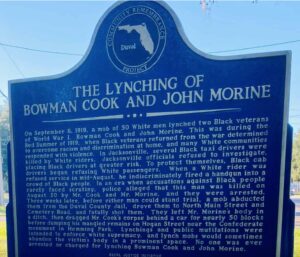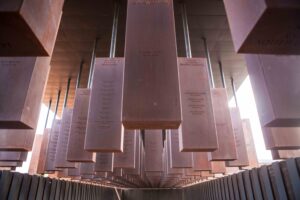Neighbors in Newtown did not want it, nor did local governments. So the lynching marker is at a church now.
By Johannes Werner
Original Air Date: Feb. 21, 2024
Host: More than 4,700 African Americans in the United States were killed in what is commonly known as “lynchings”. That’s according to the NAACP, which has tracked the terror from 1882 deep into the 20th century, 1968. Six of those murders happened in Manatee and Sarasota counties. This Saturday, a marker will be unveiled in Sarasota for these victims. On today’s Peace & Justice Report, host Tom Walker interviewed one of the organizers behind the memorial.

Lynching marker in Duval County. Photo: EJI
Johannes Werner: It’s square, it’s dark blue with gold letters, and it’s two-sided. The original plan was to erect the marker in the heart of the majority African American Newtown. Neighbors pushed back on that idea.
Dr. Caryl J. Sheffield is part of the board that oversees a three-step process to remind people in Sarasota and Manatee of the terror African Americans were facing in the South, after the end of the Civil War and slavery. She explains the location decision.
Caryl Sheffield: When they talked to people from Newtown, which is our typical or traditional black community in Sarasota, the opposition had to do with, ‘Why do we need a marker to celebrate lynching victims in Newtown? We know that that happened. We don’t need to see it all the time. Why don’t you put it in a place where other people can see it?’
JW: But that idea didn’t get far – not surprisingly, according to Sheffield, given the political climate in Florida.
CS: From what I understand, several places, governmental places, spots in Sarasota, Manatee, were approached about putting it in there, the marker, in the community and it was refused. It was refused.
JW: So now the marker will be unveiled in the front yard of a church on the outskirts of the city, facing a major thoroughfare.
In an interview with Tom Walker of the Peace & Justice Report on WSLR this morning, Sheffield revealed a personal connection to the terror: Her grandfather was killed in a small town in Georgia in 1915.
CS: My father’s father, Cesar Sheffield, was lynched in 1915 in Lake Park, Georgia. Lake Park, Georgia is a small town, it’s near Valdosta. It’s in Lowndes County, Georgia. And I didn’t know the circumstances or how it happened until one day, probably about 30 years ago. I googled – it was about the time where you can google – that’s when I googled my grandfather’s name, Cesar Sheffield, and what came up was an entry in a digest-type book: 100 Years of Lynching. It was a small little paragraph, and in this book are hundreds and hundreds of digests, short stories about lynching victims across the country. So it’s sort of gathering information, and seeing what else I can find. And so one day my husband and I decided we would take a trip to Lake Park to see what information we could get. It’s a really interesting, funny story about what happened when we got there. We went to a restaurant in Lake Park on a Sunday morning, and there was an African American waitress that we had. And I asked her, I said, ‘Do you have ever heard this story of lynchings taking place in your area?’ And she said, ‘No’, she said, ‘I really hadn’t’. And if I could just back up for a minute, we did go to the historical society, and that little old lady said, ‘We try to forget things like that. We don’t have any information about that. We try to forget.’ So anyway, back to breakfast. The waitress said, ‘If you go next door, there’s an AME, an African Methodist Episcopal Church’. She said, ‘You park your car in that parking lot, and so when the church gets out, people will notice that this is a strange car. They’re going to come out and they’re going to ask you what you’re doing there, and you ask them what they heard. About this lynching.’ So we did exactly that. And this family comes out and we hit the jackpot. The family that came, they took us on a tour of Lake Park. They showed us the jail where they assumed that Cesar was held. They showed us the smokehouse where they thought that he was there. They thought that he stole meat from there, because he was accused of stealing meat. That was why he was put in jail. They showed us the railroad tracks, where they think near there, near the railroad tracks is where his body was found.
JW: The unveiling of the marker will be this Saturday morning on the premises of the Unitarian Universalist congregation on Fruitville Road in Sarasota. It is the outcome of a five-year process, begun by Dan Boxser of the Boxser Diversity Initiative. What prompted him into action was seeing the lynching memorial set up by the Equal Justice Initiative in Montgomery, Alabama. Back home, he forged an alliance with Association for the Study of African American Life and History, the Sarasota African American Cultural Coalition, and Newtown Alive. In a first step, the alliance began a high school student essay contest. The second step is the historical marker, and the third step will be a collection of soil collection samples from the local lynching sites that have been identified by the Equal Justice Initiative.

The lynching memorial in Montgomery.
Those soil samples will be part of the memorial in Montgomery.
CS: This soil is collected, put in a jar, and the jar is labeled. It’s like a big gallon-milk container. Remember those old fashioned things? It’s glass and you can see through it, but that’s the size of it. And it’s put in the jar and put on a shelf on display at the EJI.
JW: The event at the Unitarian Universalists this Saturday at 11 am is fully booked, but you can watch a livestream at manasotaremembers.org.
If you want to know details about the six lynchings in Manasota, you will find them on the marker.
This has been Johannes Werner for WSLR News. To listen to the full interview with Caryl Sheffield, go to wslr.org, click on “archive” and look for the Feb. 21 Peace & Justice Report.
WSLR News aims to keep the local community informed with our 1/2 hour local news show, quarterly newspaper and social media feeds. The local news broadcast airs on Wednesdays and Fridays at 6pm.